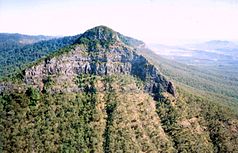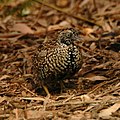Main Range National Park
| Main Range National Park | ||
|---|---|---|
| Mount Mitchell (1168 m) near Cunningham's Gap | ||
|
|
||
| Location: | Queensland , Australia | |
| Specialty: | Volcanic mountains | |
| Next city: | Warwick | |
| Surface: | 297.3 km² | |
| Founding: | 1965 | |
| The forested Main Range, in front of it Lake Moogerah | ||
The Main Range National Park is located about 116 kilometers southwest of Brisbane and 50 kilometers northwest of Warwick in Queensland , Australia . The park is named after the Main Range , a mountain range formed from volcanoes.
The national park is a UNESCO World Heritage Site as part of the Gondwana Rainforests of Australia , which were formerly also known as Central Eastern Rainforest Reserves . It protects the western part of a semicircle of mountains in southeast Queensland known as the Scenic Rim , which comprise the largest area of rainforest in southeast Queensland. The park is part of the Scenic Rim Important Bird Area , which has been designated as an important protected area by the organization BirdLife International because of various endangered bird species.
description
The park stretches from Kangaroo Mountain south to Wilsons Peak on the New South Wales border and includes Mount Superbus (1,375 m), South East Queensland's highest mountain.
The mountains Bare Rock , Mount Cordeaux , Mount Mitchell , Spicer's Peak , Mount Huntley , Mount Asplenium , Mount Steamer , Steamer Range , Lizard Point , Mount Roberts , Mount Mistake and Mount Superbus are within the Main Range National Park; in total there are more than 40 mountains that rise over 1000 meters. There are hiking trails, campsites and picnic areas in the national park, as well as other scenic spots such as Spicers Gap , Cunninghams Gap and Queen Mary Falls .
geology
The Main Range consists of shield volcanoes that formed in the Tertiary 25 to 22 million years ago . Thereafter, the centrally located mountains formed when the volcanoes erupted and flowed out as lava , filling these rock passages and forming horizontally located basalt fields. The basalt rivers formed the bulk of the Main Range , Little Liverpool Range and Mistake Range and once encompassed a much larger area which also included the Lockyer Valley and Fassifern Valley .
Flora and fauna
The steep slopes of the national park have never been worked on by humans and form a retreat for wildlife. The vegetation is dominated by subtropical rainforest and hardwood forest. The forests and mountain forests provide habitat for many animals, including Eastern bristlebird ( Dasyornis brachypterus ), Coxen's fig- parrot ( Cyclopsitta diophthalma coxeni ), and black-breasted chicken ( Turnix melanogaster ), which are threatened with extinction. The endangered and rare fox shark ( Erythrotriorchis radiatus ) has also been seen.
The Giant Barred Frog ( Mixophyes iteratus ), Fleay's Barred Frog ( Mixophyes fleayi ), Giant Pouch Marten ( Dasyurus maculatus ) and the Hastings River Mouse ( Pseudomys oralis ) are listed as endangered species that were once common in the Goomburra Valley park area .
history
The Spicers Gap is believed to be a traditional route between the inland and the coast used by the indigenous people. The rancher Henry Alphe discovered the Spicers Gap in 1847. The Spicers Gap Road allowed goods to be transported to and from Darling Downs and is an example of 19th century Queensland engineering.
The botanist Allan Cunningham is considered to have discovered another route across the Main Range in 1828. The Cunninghams Gap , named after him, can, however, easily be seen from Brisbane .
In 1840 Ernst Dalrymple settled in the Goomburra Valley . The Dalrymple Creek is named after early settlers. Around 1847 a new road was run through the Spicers Gap which opened the area for European settlement. In 1909 the area around the Cunninghams Gap was declared a national park.
In 1994 the national park with the Central Eastern Rainforest Reserves of Australia and the Goomburra Forest Reserve in the Main Range National Park was declared a UNESCO World Heritage Site. In 2007, the Gondwana rainforests of Australia and thus also the Main Range National Park were entered in the Australian National Heritage List .
Tourist information
There are three camping options in the park and numerous hiking trails.
Web links
- Official site of the park (English)
Individual evidence
- ↑ Australian Government - CAPAD 2010 ( MS Excel ; 170 kB), DSEWPaC , accessed on January 7, 2013 (English)
- ↑ Australian Government - CAPAD 1997 ( MS Excel ; 93 kB), DSEWPaC , accessed on January 7, 2013 (English)
- ^ Official Park Website - About , Queensland Parks and Wildlife Service , accessed January 7, 2013
- ^ A b c Queensland Environmental Protection Agency: Heritage Trails of the Great South East. 2000, ISBN 0-7345-1008-X , p. 34.
- ^ BirdLife International. (2011). Important Bird Areas factsheet: Scenic Rim. Downloaded from http://www.birdlife.org/ on October 3, 2011
- ↑ a b Hema Maps: Discover Australia's National Parks . Random House Australia, Milsons Point, New South Wales 1997, ISBN 1-875992-47-2 , pp. 186 .
- ↑ a b Neville Stevens and Warwick Willmott: The Main Range (pdf; 308 kB) In: Rocks and Landscape Notes . Geological Society of Australia . Archived from the original on July 19, 2008. Info: The archive link was inserted automatically and has not yet been checked. Please check the original and archive link according to the instructions and then remove this notice. Retrieved July 1, 2009.
- ^ Robert Rankin: Secrets of the Scenic Rim . Rankin Publishers, 1992, ISBN 0-9592418-3-3 , p. 18.
- ^ Environmental Protection Agency. Wildlife Online Extract: Species List. Retrieved April 2, 2006.
- ↑ Official Park Website - Camping , Queensland Parks and Wildlife Service , accessed January 7, 2013
- ↑ Explore Main Range National Park (PDF; 2.8 MB), Queensland Parks and Wildlife Service , accessed January 7, 2013 (English)






